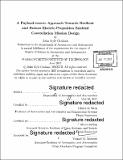| dc.contributor.advisor | Olivier de Weck and Afreen Siddiqi. | en_US |
| dc.contributor.author | Graham, John Kyle | en_US |
| dc.contributor.other | Massachusetts Institute of Technology. Department of Aeronautics and Astronautics. | en_US |
| dc.date.accessioned | 2017-12-05T19:13:56Z | |
| dc.date.available | 2017-12-05T19:13:56Z | |
| dc.date.copyright | 2017 | en_US |
| dc.date.issued | 2017 | en_US |
| dc.identifier.uri | http://hdl.handle.net/1721.1/112463 | |
| dc.description | Thesis: S.M., Massachusetts Institute of Technology, Department of Aeronautics and Astronautics, 2017. | en_US |
| dc.description | Cataloged from PDF version of thesis. | en_US |
| dc.description | Includes bibliographical references (pages 187-189). | en_US |
| dc.description.abstract | Recent studies have shown that distributed spacecraft missions, or constellations, can offer similar performance to monolithic satellite missions for lower cost and less risk. Additionally, recent developments in and implementation of electric propulsion (EP) technologies further the case for the use of constellations because they enable operational possibilities otherwise unavailable to satellites with chemical thrusters by reducing costly fuel requirements. Through more efficient fuel usage, EP allows for wide-scale rendezvous of satellites for refueling/maintenance as well as constellation reshuffling and orbit raising to recover system performance after losing a satellite. With these constellation-wide maneuvers at an operator's disposal, distributed spacecraft missions will be able to operate longer and will have more flexibility to adapt and respond to malfunctions in the constellation. This thesis analyzes the performance gains of distributed spacecraft missions that utilize EP by analyzing satellite constellations at both microscopic and macroscopic levels - first, by understanding how payloads of different types, when combined with higher power requirements for EP systems, impact and influence an individual satellite's design and mass, and then exploring how, within a 2D orbital plane, this individual satellite can use its greater endurance to move within the network and influence entire constellation performance. Together, these different levels of understanding provide the necessary framework to effectively design and analyze robust and effective constellations, regardless of mission type. A case study of the OneWeb global internet mission demonstrates that use of currently available electric propulsion technologies can save up to 3000 kg per plane over chemical thrusters and can completely eliminate the need for spare satellites for lifetime failure rates of up to 10%. | en_US |
| dc.description.statementofresponsibility | by John Kyle Graham. | en_US |
| dc.format.extent | 189 pages | en_US |
| dc.language.iso | eng | en_US |
| dc.publisher | Massachusetts Institute of Technology | en_US |
| dc.rights | MIT theses are protected by copyright. They may be viewed, downloaded, or printed from this source but further reproduction or distribution in any format is prohibited without written permission. | en_US |
| dc.rights.uri | http://dspace.mit.edu/handle/1721.1/7582 | en_US |
| dc.subject | Aeronautics and Astronautics. | en_US |
| dc.title | A payload-centric approach towards resilient and robust electric-propulsion enabled constellation mission design | en_US |
| dc.type | Thesis | en_US |
| dc.description.degree | S.M. | en_US |
| dc.contributor.department | Massachusetts Institute of Technology. Department of Aeronautics and Astronautics | |
| dc.identifier.oclc | 1011035309 | en_US |
